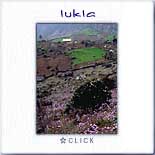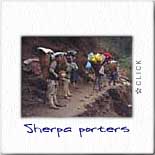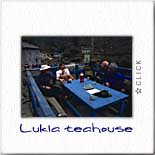
from Namche to Thyangboche
Map
of the Khumbu
The Gear
that got us there
April 1:
Kathmandu
April 2:
Kathmandu
April 3:
Kathmandu
April 4:
Lukla and Phakding
April 5:
Namche
April 6:
Between Namche and Thyangboche
April 7:
Thyangboche
April 8:
Thyangboche
April 9:
Dingboche
April 10:
Dingboche
April 12:
Lobuche
and
Beyond
Trek photos by Peter Potterfield, © 1997 The Zone Network. All rights Reserved.
![]()

 The expedition charters one of the big Russian MI-17 helicopters to get
the people and gear from Kathmandu to Lukla. It's been a tough year
moving people there, lots of rain, lots of canceled flights. Wally Berg
of our group tried three times over three days to get to Lukla before
managing to catch a Royal Nepal Twin Otter. He finally made it, and is somewhere up ahead. Todd
Burleson has to stay behind in Kathmandu for his oft-delayed official
ministry briefing, so it's a reduced crowd that boards the helicopter.
Even so, we're lucky: the load limit on these things is 3000 kilos, and
were just 20 kilos under by the time we're all weighed and loaded.
The expedition charters one of the big Russian MI-17 helicopters to get
the people and gear from Kathmandu to Lukla. It's been a tough year
moving people there, lots of rain, lots of canceled flights. Wally Berg
of our group tried three times over three days to get to Lukla before
managing to catch a Royal Nepal Twin Otter. He finally made it, and is somewhere up ahead. Todd
Burleson has to stay behind in Kathmandu for his oft-delayed official
ministry briefing, so it's a reduced crowd that boards the helicopter.
Even so, we're lucky: the load limit on these things is 3000 kilos, and
were just 20 kilos under by the time we're all weighed and loaded.
| ...the sounds of the tea house lodgings — and in the Khumbu that's not unlike the noise of a TB ward — reverberate through the thin walls. |
We're lucky again when we arrive at Lukla about two minutes before heavy gray clouds descend to obscure the sharply angled air strip there. We make it, but the machine is marooned by the lowering overcast. They tell me that the Russian pilots, in their pressed slacks and starched shirts with smart epaulettes, hate to be marooned at funky-beyond-belief Lukla. You can't blame them.
 It takes our Sherpa staff
hours to get all the gear off-loaded, sorted into yak and porter
loads, and assembled for the trek. There's lots of conversation about
making sure the satellite
telephones and the gel-pack batteries and solar panels and surround
camera are all accessible. Eric Simonson, Greg Wilson, Leslie Buckland,
Charles Corfield, Freddy Blume and I chill in the dark confines of a
local tea house, swilling strong black tea and biding our time until sirdar
Lhakpa Rita tells us it's time to hit the trail.
It takes our Sherpa staff
hours to get all the gear off-loaded, sorted into yak and porter
loads, and assembled for the trek. There's lots of conversation about
making sure the satellite
telephones and the gel-pack batteries and solar panels and surround
camera are all accessible. Eric Simonson, Greg Wilson, Leslie Buckland,
Charles Corfield, Freddy Blume and I chill in the dark confines of a
local tea house, swilling strong black tea and biding our time until sirdar
Lhakpa Rita tells us it's time to hit the trail.
Our group makes a long file of loaded yaks, porters, Sherpa climbers, and Westerners that quickly loses its cohesion on the busy trail out of Lukla. It's a dreary walk that begins in a drizzle, but rhododendron blossoms and wild flowers dot the hillsides as we contour around through Choplung. At Ghat there are two large prayer wheels, some really soaring prayer flag poles, and a couple of huge boulders brightly painted with the Buddhist mantra: OM MANI PADME HUM. It starts raining in earnest.
 Finally we descend to Phakding, which at 9,000' actually a few
hundred feet lower than Lukla, where a long suspension bridge (guyed out
at its mid-point to keep it from whipping about dangerously)
crosses the Dudh Kosi. I cross the swaying span in a driving rain. A
large French trekking party has pitched tents in the yard of one of the lodges. For us there's no thought of camping in the wet, so we file in and find rough accommodation at a tea
house. It's good to be out of Kathmandu, but the excitement of finally
being in the mountains is muted by the fact that we've been walking
through a wet cloud all day.
Finally we descend to Phakding, which at 9,000' actually a few
hundred feet lower than Lukla, where a long suspension bridge (guyed out
at its mid-point to keep it from whipping about dangerously)
crosses the Dudh Kosi. I cross the swaying span in a driving rain. A
large French trekking party has pitched tents in the yard of one of the lodges. For us there's no thought of camping in the wet, so we file in and find rough accommodation at a tea
house. It's good to be out of Kathmandu, but the excitement of finally
being in the mountains is muted by the fact that we've been walking
through a wet cloud all day.
The tea house scene, too, is an acquired taste. Like a lot of Khumbu travelers, I generally prefer to camp. The tea houses along the long Khumbu route are full of sick strangers, tired trekkers and wigged-out hippies, coughing and talking nonsense. You can encounter some cool people, for sure, but there's just no telling what or who you're going to find.
 Most independent trekkers who don't have the resources of an organized
trekking or climbing group use the tea houses. These lodges/restaurants
are a thriving
and important local industry in the Khumbu because they make travel
relatively easy: with just a sleeping bag and a few rupees, one can
travel
and eat and sleep throughout the area, all the way to Everest — although
the quality of the accommodation and food declines at the far end. Even
expeditions such as ours
make use of these lodges, particularly lower down, although our own
kitchen
staff prepares all our meals. These feasts, by the way, eventually are
brought to our table in the tea
house dining room and become the focus of envious stares from less
pampered travelers. After dinner we retire to our shared "rooms," tiny
plywood
cubicles with hard benches for beds, where we climb into sleeping bags
and fire up headlamps and Walkmans to
read and listen to music as the sounds of the tea house lodgings — and in
the Khumbu that's not
unlike the noise of a TB ward — reverberate through the thin walls.
Most independent trekkers who don't have the resources of an organized
trekking or climbing group use the tea houses. These lodges/restaurants
are a thriving
and important local industry in the Khumbu because they make travel
relatively easy: with just a sleeping bag and a few rupees, one can
travel
and eat and sleep throughout the area, all the way to Everest — although
the quality of the accommodation and food declines at the far end. Even
expeditions such as ours
make use of these lodges, particularly lower down, although our own
kitchen
staff prepares all our meals. These feasts, by the way, eventually are
brought to our table in the tea
house dining room and become the focus of envious stares from less
pampered travelers. After dinner we retire to our shared "rooms," tiny
plywood
cubicles with hard benches for beds, where we climb into sleeping bags
and fire up headlamps and Walkmans to
read and listen to music as the sounds of the tea house lodgings — and in
the Khumbu that's not
unlike the noise of a TB ward — reverberate through the thin walls.